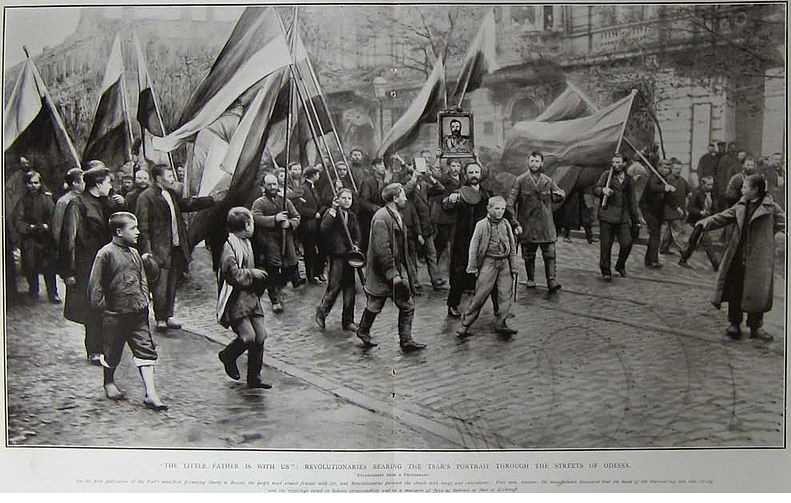
This picture appears all over the internet as a demonstration of the 'Black Hundreds' but the caption in the Illustrated London News reads 'The Tsar is with us - Revolutionaries bearing the Tsar's portrait through the streets of Odessa.' Unable to read the very small print, the Russian flags, the Tsar's portrait and the absence of icons would suggest to me that it is a straightforward demonstration thanking the Tsar for the October Manifesto.
AFTER THE OCTOBER MANIFESTO
Weinberg (p.61) describes the rejoicing that followed the proclamation:
'The storm broke on October 18. News of the October Manifesto had reached Odessa officials on the previous evening, and by the next morning thousands of people thronged the streets to celebrate. As one university student exclaimed, "A joyous crowd appeared in the streets - people greeted each other as if it were a holiday." Jews were joined by non-Jews in vigorously and enthusiastically celebrating the granting of civil rights and political liberties.
'At first the crowds were peaceful, but the quiet did not last long. Soon after the demonstrations began, several individuals began to unfurl red flags and banners with anti-government slogans. Others shouted slogans like "Down with the Autocracy," "Long Live Freedom," and "Down with the Police." Apartment dwellers draped red carpets and shawls from their balconies and windows, while groups of demonstrators forced passersby to doff their hats or bow before the flags. In the city duma building, demonstrators ripped down the portrait of the tsar, substituted a red flag for the Imperial colors and collected money for weapons. The city governor also reported that one group of demonstrators tied portraits of the tsar to the tails of dogs and then released them to roam the city. The mood of the demonstrators grew more violent as the day wore on. Mobs of demonstrators - primarily Jewish youths, according to official accounts - viciously attacked and disarmed policemen. By mid-afternoon Neidgart [the Odessa governor - PB] had received reports that two policemen had been killed, ten wounded and 22 disarmed, and that many others had abandoned their posts in order to avoid possible injury.'
Already, though, there was some opposition to all this rejoicing (p.62):
'Armed confrontations originated near the Jewish district of Moldavanka in the afternoon and early evening of October 18. The clashes apparently started when a group of Jews carrying red flags in celebration of the October Manifesto attempted to convince a group of Russian workers to doff their caps to the flags. Harsh words were exchanged, a scuffle ensued, and then shots rang out. Both groups scattered, but quickly reassembled in nearby streets and resumed their fighting. The clashes soon turned into a pogrom, as Russians indiscriminately attacked Jews and began to vandalise and loot Jewish homes, apartments and stores. The military on October 18 was equally vigilant in its efforts to restrain both gentile and Jewish rioters, vigorously suppressing the disturbances. Cossacks soon arrived on the scene and restored order by early evening'
It was the following day, October 19th, that 'the pogrom began in full force'. A patriotic rally was organised to show loyalty to the Tsar. It included many workers, including day labourers working on the docks, the group Weinberg eventually identifies as mainly responsible for the pogrom. The crowd carried icons and portraits of the Tsar and held a brief service in the cathedral:
'Suddenly, shots rang out, and a young boy carrying an icon lay dead. Most accounts of the incident assert that the shots came from surrounding buildings. No one knows for certain who was responsible for the shots, but evidence strongly suggests that they were fired by revolutionaries or members of Jewish and student self-defence brigades. In any case, the crowd panicked and ran through the streets as more shots were fired from rooftops, balconies, and apartment windows. Revolutionaries and self-defence units organised by students and Jews threw homemade bombs at the demonstrators, indicating that they were ready to instigate confrontations. The shootings triggered a chain reaction. Convinced that the Jews were responsible for the shootings, members of the patriotic demonstration began to shout "Beat the Kikes" and "Death to the Kikes," and went on a rampage, attacking Jews and destroying Jewish apartments, homes, and stores.'